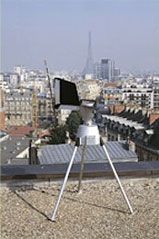
Pollen trap and orifice

The main allergenic pollens and moulds.
The operating principle of RNSA is based primarily on the establishment of stations collecting bakground measurments. Each stations was chosen in relation to climatic and botanical criteria, but also on population density. Each station consists of a pollen trap, an analyst and a clinician in charge of the station.
The coordination center, headed by Charlotte SINDT, is based in Brussieu in the heart of the Monts du Lyonnais, 40 km west of Lyon (69). This center receives the results of pollen analysis and related clinical information. Thus, it can ensure the drafting of forecasted allergo-pollinic bulletin. These bulletins are broadcast to national or regional sites, media, health authorities and all partners of RNSA. The coordination center ensures safe management of the database that enables statistical research on pollen, developing annual reports, the implementation of forecast ...
The training center, directed by Nadine DUPUY, is based in the coordination center of RNSA in Brussieu. This center ensure initial and continuing trainings of all analysts of the network, but also the quality control, the only guarantee of homogeneity and quality of the analysis.
The pollen traps.
Pollen counts are carried out by collecting pollen on volumetric Hirst type trap. This type of traps has three major characteristics which are:
• Aspiration of air flow equivalent to a regular human breathing (10 liters of air per minute).
• Transparency and stability of the support material captured with the possibility of a quick, easy and accurate analysis.
• Recording mode for daily and bi-hourly analyses.
The network of sentinel physicians.
Each station is connected to a clinical physicians in charge to organize a network including medical specialists and generalists. They collect information on the presence of pollinosis, its development and the severity of the symptoms.
The phenology network.
Over a dozen French regions, phenological observers inform the RNSA every week about the production capacity of pollen from male flowers of the main allergenic species, facilitating the forecasts of the related allergy risk due to pollen.